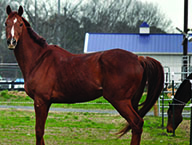
Chris Wilcox
Staff writer
Seven horses remain sick in a University isolation unit after an outbreak of strangles in two horses spread over the last two weeks. The first horse found contaminated was housed in the Gelding Lot but has since been moved to isolation.
Preventative measures are required to keep the disease from spreading rapidly.
Tony Brannon, dean of the Hutson School of Agriculture, said strangles is manageable and is comparable to strep throat in humans. It is easily spread in confined spaces, but also easily remedied, he said.
Brannon said several years ago there was a situation dealing with equine herpes virus which was much more dangerous. Due to that outbreak, a network of protocol was created. This protocol was amended for the current circumstances.
“With ongoing activities there is no need to escalate any fears,” he said.
The first test for confirmation was done by the Animal Disease Diagnostic Lab at the Breathitt Center in Hopkinsville, Ky., on Friday, Feb. 24, and within 24-hours pathologists had confirmed the horse in question had strangles.
Since then, six other horses have been diagnosed.
Immediately following suspicion, the horses were put into isolation and Murray State called into action a plan to prevent the spread of the disease.
Noel Thomas, veterinarian with the Westside Veterinary Service in Murray said strangles, caused by the bacterium, Streptococcus equi, is a disease in horses and other equids characterized by inflammation of the mucosa of the head and throat. The illness often causes swelling and rupture of the lymph nodes, which produces pus.
“Strangles is primarily a respiratory infection,” he said. “The most common symptoms are inflamed lymph nodes, fever and a snotty nose.”
All the horses housed at the Murray State Equine Center’s horse barns are being monitored for signs of infection. Any horse that shows sign of Strangles will be moved to the quarantine facility at North Farm.
The staff are taking temperatures of the horses and if a temperature above 102 F is measured, the horse will be moved to isolation. Other signs of infection can include visible blistering of the animal’s lymph glands and a nasal discharge.
If a horse is moved into isolation, it will not be placed back in group housing until it is proven free of strangles, which can be determined by three negative nasal swabs at four to seven day intervals, with the minimum isolation period being one month.
Thomas said curative measures include penicillin and nursing care. Nursing care consists of trying to hasten the development of abscesses, which can be drained by hot packing and then extracting the pus.
“If you can let the disease run its course, the animal usually does better in the long run,” Thomas said.
The disease may be spread from animal to animal, by human contact or from contaminated feed and water bowls, but humans cannot fall victim to the bacteria.
The University vaccinated all the horses before the first case was diagnosed.
Thomas said Strangles is more common in younger horses, as their immune systems are not as strong as the older animals’.
The horses affected were not the property of any University students, rather, the ones proven infected were primarily used for instructional purposes.
Brannon said there were no restrictions on any use of the facilities, since there has been a thorough sanitation.
“There are absolutely no restrictions on the facilities by concurrence of the Kentucky Department of Agriculture,” he said.
He also said the outbreak has had little impact on the students in the animal and equine science program. However, the Intercollegiate Horse Show Association Hunt Seat Show scheduled for March 1 and 2 was canceled because there were not enough horses in the teaching heard available for the event.
“We had a team sorting event last weekend in our facility and we have some upcoming rodeo events,” Brannon said. “So there should be little to no impact on the (rodeo and equine team).”
Brannon said as the detection of strangles is reportable to the Kentucky Department of Agriculture, the University contacted the department to substantiate the efforts the University has done to minimize the effects.
Tim Busse, senior from Farina, Ill., said he has two horses at the Murray State Equine Center and has had no fear about the disease strangles or its spread.
“I haul and show horses often and have seen strangles many times,” he said. “Horses build up a natural immunity to it; there is no big issue.”
He said usually the disease effects younger horses as they have not built up the immunity older horses have.
Rebecca Elkins, sophomore from Bloomfield, N.J., said using the strangles plan was the right choice, but fears it might have been used too late.
“Horses were showing serious illness signs for a week before this happened,” she said.
She said at the time of the outbreak and for the following week her equine classes were canceled, and she said it is her belief that classes are resuming too soon, as the proper quarantine time for strangles is about a month.
She said she thinks other horses at the University barns may have strangles, undetected.
She does not want to risk transferring the disease to her horse, something she fears if spending time at that site.
Her horse is located at an off-campus facility.
Brannon said the conditions weren’t severe but was glad the situation was handled efficiently. He said animals were the schools strongpoints and that its priority is animals’ wellbeing.
Said Brannon: “Our No. 1 priority will always be in the welfare of the animals, not only from a regulatory standpoint but because it’s the right thing to do.”